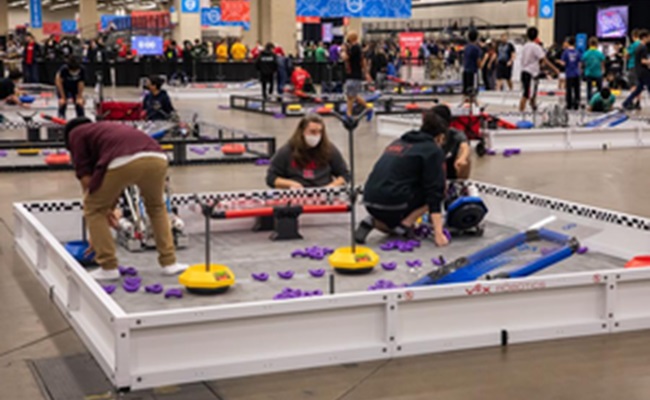
A small robot ran around the field, turning back and forth and then swiftly from left to right, picking up triballs, a ball in the shape of a triangle, and moving them into a net goal zone, then climbing a pole and lifting itself vertically off the field.
Amazingly, it was all done in less than two minutes with great speed and precision!
Students at the AI Robotics Academy in Plano, a suburban city in Dallas, Texas, were rehearsing a global robotics competition project for the 2024 VEX World Robotics Championship concluded in Dallas on May 3.
Instead of retelling the refined and themed knowledge of science, technology, engineering and mathematics (STEM) that students learn in classrooms, the after-school club inspires and guides robotics learners to find out the original point of the knowledge and theories through realistic explorations, trials and experiments, Kan Xu, head coach of the club, told Xinhua News Agency.
Robotics education can help students understand other similar devices they see around them, Xu said.
"They find out what sensors and electric motors do and how they work in real life," he added. "We provide 3D printers and drawing tools. Students can design and draw anytime anywhere."
Through small contests and games embedded in the coaching process, the children gradually make progress and complete targeted tasks.
In his club, depending on the level of understanding, the training could be one-on-one or team work, Xu said. The coaching time could range from two hours to over six hours a week.
Robotics education is getting increasingly popular in the United States, Xu said.
It seems that in recent years, public and private schools, as well as professional clubs, have been getting into robotics education after class across the country.
With government funding, coaches at U.S. public schools lead, supervise and organize extra-curricular activities. Private clubs and schools fundraise themselves and set up students-oriented goals of all ages from elementary schools to high schools.
Likewise, the Innovation Station, a portable classroom with 3D printers and other equipment designed to make STEM education more accessible to students, is booming across U.S. schools, according to Xu. He thinks the trend could help establish an interdisciplinary connection to tap the talents of all ages in learning AI robotics.
Also, over the past three decades, a bunch of state and regional competitions, as well as nationwide open games across the United States, have all helped show off what the robotics learners have achieved.
For instance, the annual VEX World Robotics Championship, sponsored by a number of U.S. tycoons including NASA, the U.S. Air Force, Microsoft, Google and Tesla, has already been recognized by Guinness World Records as the largest robotics competition in the world.
Xu was very excited that AI Robotics Academy was crowned World Champion of Skills during the championship. "It means a lot to our team," Xu said.
In addition to the VEX tournament, a series of high school competitions at the state, national and international levels organized by FIRST Robotics Competition have been widely recognized as a significant factor in the admission of students to U.S. universities, according to Xu.
Winning the awards is a testament to the students' STEM skills and knowledge, he added.
Experts say that robotics education is set to change the way children learn by giving them the skills they need to succeed in a future where AI and robotics are an integral part of their lives.
According to ResearchAndMarkets.com, the demand for education technology solutions and services is quite high in North America owing to the huge presence of educational robot manufacturing companies, smart device manufacturers, cloud service providers, and a high adoption of advanced technologies such as robots among schools and educational institutions.
It's possible that in the future, children will learn from educational robots on how to design, make and play with robots, local observers said.













